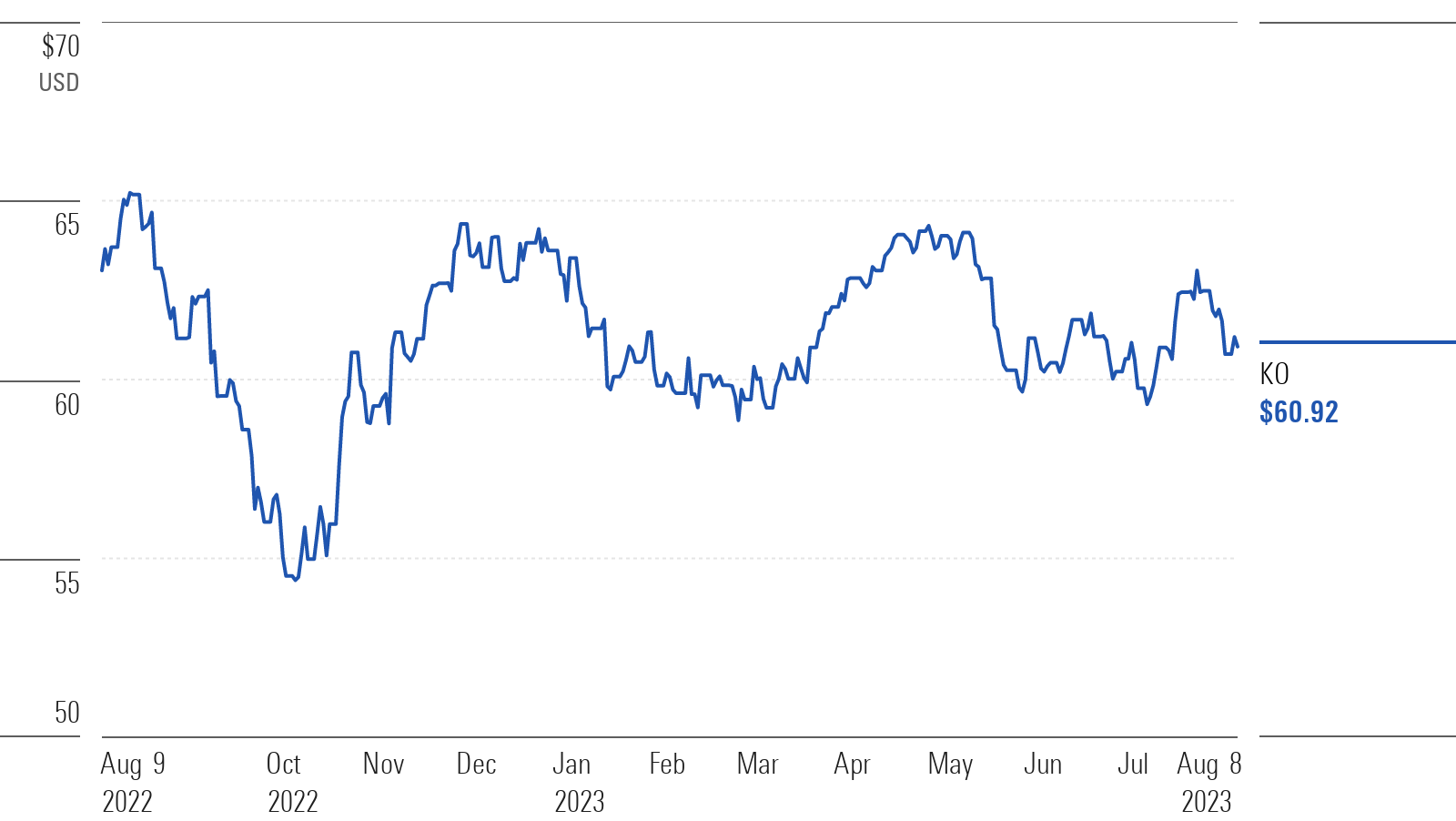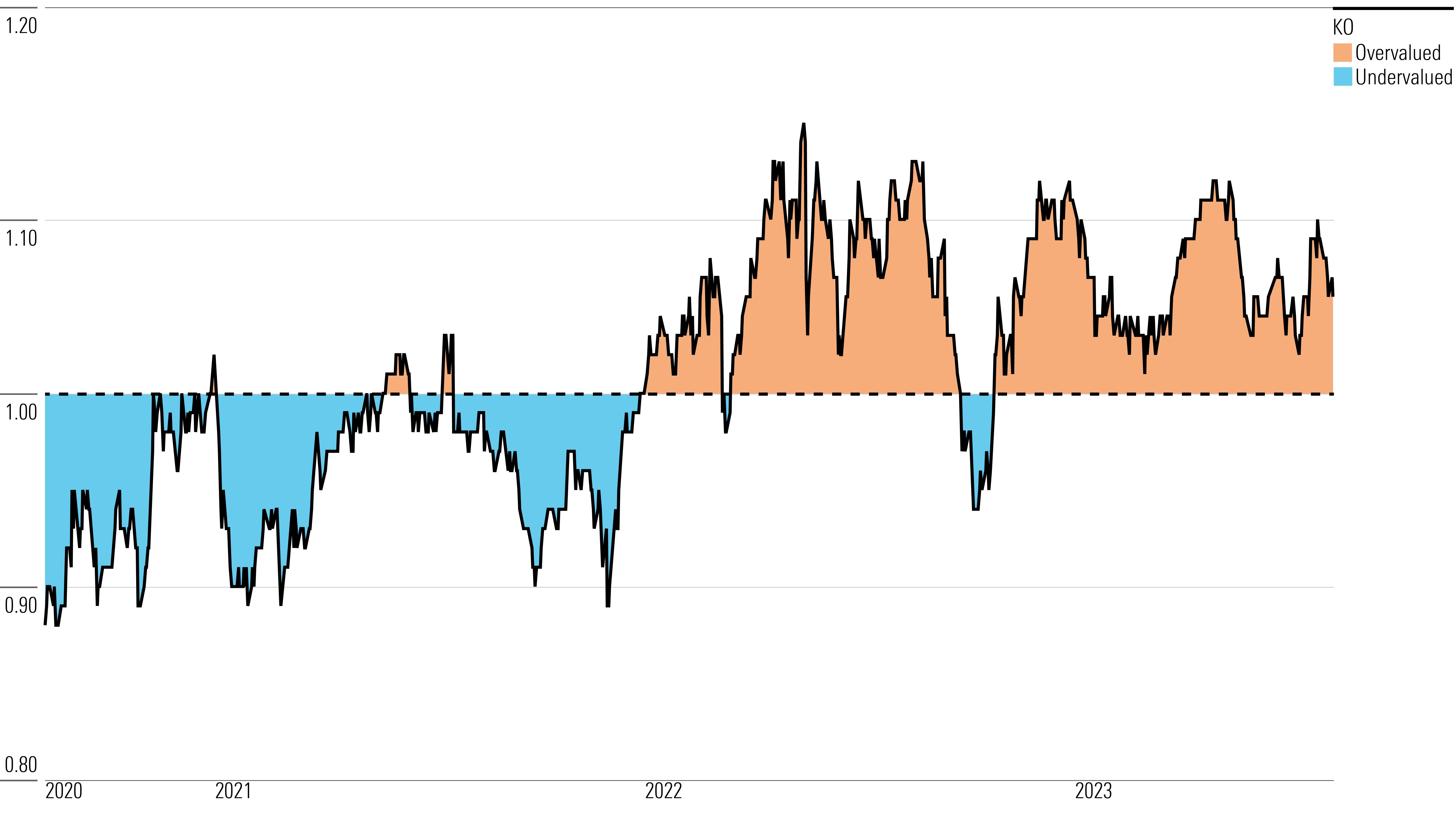After Earnings, Is Coca-Cola Stock a Buy, a Sell, or Fairly Valued?
With growing revenue driven by consumer-centric innovations, here is what we think of Coca-Cola’s earnings and stock.

Coca-Cola KO released its second-quarter earnings report on Wednesday, July 26, 2023, before the market open. Here’s Morningstar’s take on what to think of Coca-Cola’s earnings and stock.
Key Morningstar Metrics for Coca-Cola
- Fair Value Estimate: $58.00
- Morningstar Rating: 2 stars
- Morningstar Economic Moat Rating: Wide
- Morningstar Uncertainty Rating: Low
What We Thought of Coca-Cola’s Q2 Earnings
- Revenue growth: Coke posted better-than-expected results, driven by beverage innovations and in-market execution in both premium and value offerings globally. Organic revenues grew 11% and adjusted earnings per share were up 17% (excluding currency impact), both ahead of our estimates (10% and 14%, respectively). Coke nudged up its 2023 guidance ranges for organic revenue to 8%-9% (from 7-8%) and adjusted EPS growth to 5%-6% (from 4%-5%), which we view as achievable. We plan to update our own 2023 estimates to approximate the new outlook. Our 10-year projections for mid-single-digit sales growth and low-30s average operating margins remain in place.
- Consumer-centric innovations: Key topline growth drivers in the quarter included refreshed Minute Maid juice offerings and alcoholic ready-to-drink beverages under the Jack & Coke and Schweppes brands, along with astute in-market executions with products and prices tailored to different channels and regions. Bottlers’ digital investments to connect traditional retailers also helped unlock new volumes. Because of this, despite a 10% price mix increase (consistent with pricing reported by peer PepsiCo PEP), volumes were flat even as consumers tightened their purse strings. The strong performance reaffirmed our view that consumer-centric innovations and brand marketing should continue to reinforce Coke’s competitive standing and fuel steady sales and profit expansion in the coming years.
- Price hikes: We anticipate limited new price hikes in the coming quarters as cost inflation eases (mid-single-digit increases in the commodity basket for 2023). While management acknowledged a slight uptick in promotions, we think the soft drink aisle remains rational and that Coke is well-positioned with its dual-pronged strategies on premium and value products. We expect Coke to plow more in brand investments to stay connected to consumers, with such spending at 11% of sales in 2023 (versus 10% in 2022), reinforcing the brand intangibles that are core to its long-term competitive standing.
Coca-Cola Stock Price

Fair Value Estimate for Coca-Cola
With its 2-star rating, we believe Coca-Cola’s stock is overvalued compared with our long-term fair value estimate. We are maintaining that fair value estimate at $58 per share, which implies 23 times multiple against our adjusted 2023 earnings estimate and a 2023 enterprise value/adjusted EBITDA multiple of 19 times. We continue to forecast mid-single-digit top-line growth and high-single-digit earnings growth over our 10-year explicit forecast.
Our projection of a 5.2% compound annual growth rate for Coke’s revenue over the next 10 years is driven by strong emerging market growth (we forecast Latin America and the Asia-Pacific combined to make up 30% of overall sales by 2032, up from 22% in 2022), with expansion in non-sparkling categories (water, sports, and energy drinks) steadily adding offerings in the on-premises channel and for retail distribution.
While 2022 revenue growth (11% on a reported basis) is largely driven by increases in price/mix as Coca-Cola flexes its pricing muscle amid cost inflation and currency headwinds, we forecast top-line growth to be more balanced between price/mix and volume in 2023 and onward. We see growth settling back into the 4%-6% long-term target range set by management, which we believe is appropriate, given industry dynamics. Coke has historically augmented organic growth with strategic acquisitions, and we expect the company to continue to do so in the coming years. However, given a lack of information about its acquisition pipeline, we will refrain from incorporating mergers and acquisitions deals into our financial modeling until we have better visibility.
Read more about Coca-Cola’s fair value estimate.
Coca-Cola Historical Price/Fair Value Ratios

Economic Moat Rating
We believe Coca-Cola has built a wide economic moat around its global beverage operations, based on strong intangible assets and a significant cost advantage that will enable the company to deliver excess investment returns above its cost of capital over and beyond the next 20 years.
As the world’s best-known beverage company, Coke owns a strong portfolio of storied and iconic brands that resonate with consumers everywhere, making its products the beverages of choice for both at-home and away-from-home consumption occasions.
The special connection Coca-Cola cultivates and maintains with generations of consumers has enabled the firm to dominate the carbonated soft drink category at the core of its business (69% of Coca-Cola’s 2022 unit case volumes sold). As evidenced by Beverage Digest data, Coca-Cola commands a convincing lead with a 46.3% share of the U.S. market’s unit case volume in 2021, more than 20 percentage points ahead of PepsiCo, its main competitor (which had a 25.6% share).
Other than the flagship Coca-Cola brand, other top-selling soft drinks with loyal followings from the company include Sprite, Fanta, Diet Coke, and Coke Zero. Leveraging Coca-Cola’s retail relationship, the firm has been able to establish a strong position in adjacent categories as well, such as water, juice, and sports drinks, with brands such as Dasani, Minute Maid, and Powerade.
Read more about Coca-Cola’s moat rating.
Risk and Uncertainty
We assign Coca-Cola a Low Uncertainty Rating. We view its strong bottler relationships as crucial to its business model and return profile, but in periods of high inflation, these relationships could come under pressure, as the bottlers tend to bear the brunt of cost increases. This is less of an issue in the United States, where local bottlers are small and have limited bargaining power. But in emerging markets—which hold the key to healthy volume growth—Coca-Cola faces much larger bottlers, such as Arca Continental and Coke Femsa, which are in better positions to negotiate.
Although nonalcoholic beverage demand tends to be resilient through economic cycles, Coke has high exposure to international markets (over two-thirds of both revenue and profits), which leads to stepped-up volatility within its operations compared with its domestically focused peers, thanks to shifting macroeconomic and regulatory landscapes, currency fluctuation, and geopolitical risks. Management’s international experience, combined with global bottler collaborations, can help the firm tackle these challenges.
Read more about Coca-Cola’s risk and uncertainty.
KO Bulls Say
- Coke can leverage strong bottler relationships in underpenetrated emerging markets to drive volume growth with both classic recipes and new products tailored to local tastes.
- Heavy investments in a digitalized supply chain and data analytics have better aligned Coke and its bottlers in product planning, manufacturing, and go-to-market strategy.
- As Costa recovers from COVID-19-related disruptions, it should help Coca-Cola gain a firmer footing in the coffee category and provide more consumer insights, given its global footprint.
KO Bears Say
- Secular headwinds for carbonated soft drink demand in developed markets are a challenge to Coca-Cola’s long-term growth outlook.
- The company’s brand portfolio and product lineup in nonsparkling categories are less robust, and heavy investments are needed to bolster its competitive position.
- With two-thirds of its revenues coming from international markets, Coke faces constant currency fluctuations, which drive volatilities in reported earnings.
This article was compiled by Monit Khandwala.
The author or authors do not own shares in any securities mentioned in this article. Find out about Morningstar’s editorial policies.


/d10o6nnig0wrdw.cloudfront.net/05-09-2024/t_fab10267147f40fb93a1deb8a0b6553b_name_file_960x540_1600_v4_.jpg)
/cloudfront-us-east-1.images.arcpublishing.com/morningstar/E3DSJ6NJLFA5DOKMPQRAH5STMU.png)
/cloudfront-us-east-1.images.arcpublishing.com/morningstar/EGA35LGTJFBVTDK3OCMQCHW7XQ.png)